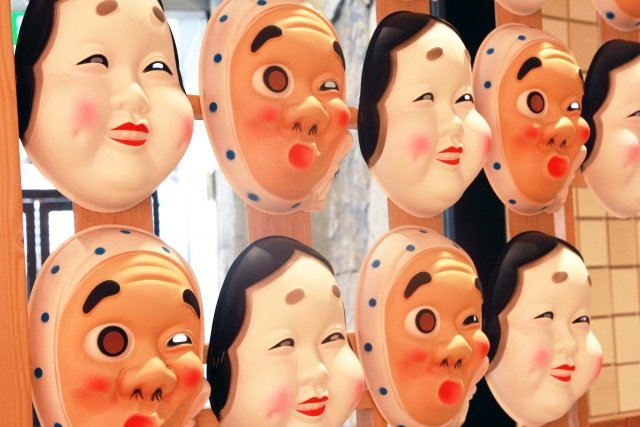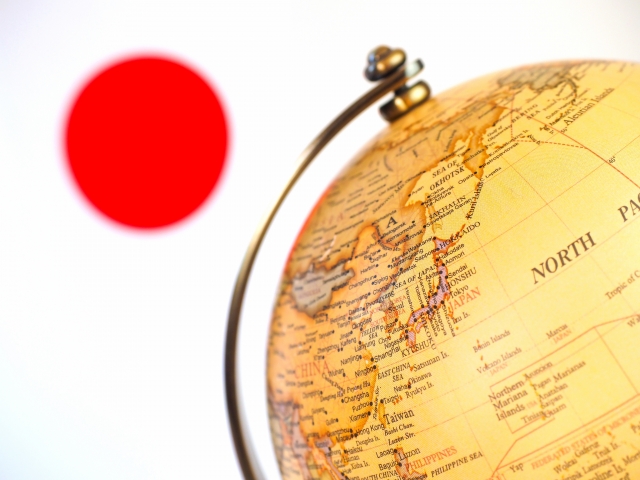Have you ever seen mysterious masks when you came to Japan? Perhaps you have seen a mask called “Hyottoko”.
By any chance, “Hyottoko mask” and “Okame mask” have been popular as lucky charms for a long time. Perhaps the reason for their popularity is their expressions that make you laugh unintentionally. However, the origin of their faces is a little ambiguous.
On this page, we will confirm the meanings and origins of “Hyottoko” and “Okame.

If you are looking for face-to-face or online Japanese lessons with the best Japanese tutors, please check here.
Contents
What is the meaning of “Hyottoko mask”?
Hyottoko” is a mask of a man with an open mouth and a frightened expression. This expression is also called “Hyottoko” or “Hyottoko face,” and is sometimes called a “squirt mask.
There are many variations of the Hyottoko, but they all have one thing in common: they give an interesting impression.
- Some have one eye that is smaller than the other.
- Many have a crooked mouth and a slanted mouth.
- Some have a pouty head and cheeks.
- When a Hyottoko mask is worn, it is often a cheek-biting mask.
The comical masks of the Hyottoko are common because of their role as clowns in dengaku dances and festival dances.
It is widely believed that the name “hyottoko” originated from the word “Hiotoko,” which means “hiotoko 火男” in Japanese, as it was used to blow the fire of a cooking stove with a bamboo pipe.
Furthermore, it is said that the name “hyottoko” came from the names “hyoutokuひょうとく” and “untokuうんとく” in the folklore of the Tohoku region.
The shape of the hyottoko mask derives from the “usobuki no men うそぶきの面” masks used in kyogen theater. This type of mask, with round eyes and a protruding mouth, was perfected in the Muromachi period (1336-1573) and has been handed down to the present day. Indeed, the Usobuki no
menうそぶきの面 mask is a “hyottoko” mask.
Hyottoko is often combined with “Okame” and “Otafuku” as a good-luck charm. Let’s look at “Okame” next.

What is the meaning of “Okame mask”?
Okame” is a female mask with a round face, broad forehead, and low nose. This type of face is also called “okame. There are different ways to write or call “Okame” as follows
- お亀(おかめ) Okame
- 阿亀(おかめ) Okame
- お多福(おたふく) Otafuku
- 阿多福(おたふく) Otafuku
- お福(おふく) Ofuku
- 御福(おふく) Ofuku
- 乙(おと) Oto
- 御前(おとごぜ) Otogoze
- 乙御前(おとごぜ) Otogoze
The following are some theories on the origin of the name otogoze
- Because the shape of its face resembles a jar.
- Taken from the name of a Muromachi period miko (shrine maiden).
- There are also several theories on the origin of Otafuku’s name, the most common of which are as follows
- It means “a lot of good fortune.
- Because the shape of his face resembles a blowfish
- It is a variant of the Kyogen pronunciation of “oto” and “otogoze”.
Neither Okame nor Otafuku is definitive, but Okame supports “the shape of the face resembles a jar” and Otafuku supports “there is a lot of good fortune”.
The origin of this Okame (Otafuku) mask is believed to be Amenouzume, the oldest female dancing princess in Japanese mythology. Amenouzume is said to be the ancestor of the “Sarume-no-kimi,” who were courtesans involved in court ceremonies since ancient times.

Otafuku meaning
By the way, do you know the word “Otafuku”? Otafuku mask is a traditional Japanese mask closely related to “hyottoko” and “okame”. Each has its own meaning and cultural background, and plays a special role in Japanese festivals and events.
“Otafuku” represents a woman’s face and is also called “Otafuku Furoshiki.” Her mask symbolizes happiness and a smile, and is used to pray for the fulfillment of wishes and prosperity. Otafuku symbolizes bringing joy and smiles to people because of its bright and smiling face. Her lovely smile is believed to have the power to ward off bad relationships and attract good ones. Otafuku masks symbolize the joyful atmosphere of Japanese festivals and festivals, and serve to bring smiles and hope to people.
Hyottoko masks and Okame masks are also traditional Japanese masks used in festivals, performing arts, etc. The Hyottoko mask has a comical expression and is sometimes used to pray for business prosperity. The Okame mask, on the other hand, symbolizes the female face and celebrates happiness and virtue. Like Otafuku, these masks emphasize the positive values of Japanese culture and are an important element in enlivening the atmosphere of festivals and events.
These masks are beloved symbols of happiness and hope at Japanese festivals and events, and are part of Japanese culture, bringing fun and joy to many people.
Conclusion
Hyottoko mask refers to a man with a slack-mouthed, crooked expression and his mask. It is also called shiofuki-men (salt-blown mask).
The size of the left and right eyes may be different, and the person may be wearing a cheek mask. Alternatively, the person wearing the mask often wears a cheek mask. They are sometimes paired with female “okame” (Ofukusan). Hyottoko often appear as clowns in dengaku and festival dances and dances.
- “Hyottoko” refers to the mask of a man with a pointed mouth and a frightened expression, or a mask with such an expression.
- A popular theory is that the name “hyottoko” is a corruption of “hiotoko” (fireman).
- The theory is that it originated from the “usobuki no men” masks used in Kyogen.
- “Okame” is a female mask with a round face, broad forehead, low nose, or something like that.
- There are various theories on the origin of the name “Okame (Otafuku),” but none is definitive.
- It is believed that the mask of Okame (Otafuku) originated from Amenouzume, the oldest female dancer in Japan.
Related article:










